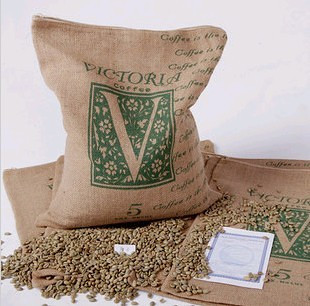How much is a kilo of coffee beans? coffee beans grow seeds in Africa, Tanzania, Kilimanjarozhen.
Coffee seeds cannot be grown directly with coffee fruits picked from coffee trees. Peeling coffee fruits is just like planting peanuts. If you plant a peanut with a shell in the soil, it cannot sprout. You must plant peanuts. It is the same with medium coffee. If you have coffee fruit in your hand, you can bask it in the sun first and shake it until it is shaken. (like sun-dried peanuts), you can peel off the shell of the coffee fruit and plant it with coffee seeds inside. Coffee trees must be planted near the equator in the tropics and subtropics at latitudes 23 °N and 25 °S. In China, only Taiwan, Hainan and Yunnan can grow coffee trees.
The cultivation of coffee beans
Indoor growth is best placed in a place with plenty of light. Non-direct sunlight or fluorescent lighting such as an office or kitchen has good light conditions.
(watering)
Place the tree in a sink or container and water until water leaks from the drain at the bottom of the basin. Repeat this step until all the roots are wet. It is usually OK to water it once a week. Don't keep the soil wet all the time. Don't water too much! To avoid getting too wet, keep the water tray under the flowerpot dry.
(fertilization)
You can buy liquid fertilizer from the horticultural shop and fertilize it according to the method of indoor plants.
(temperature)
Coffee is a subtropical plant, growing at about 61F ~ 74F (16C ~ 23C). It can withstand temperatures of about 55F (12C) to 80F (27C) and still bloom. Don't let it get cold! If you put it in the sun or in a hot place, water more so as not to wither the plants.
Coffee grows well indoors and can be an ideal home or office plant. Switching to a large flowerpot will make the tree open higher, and if the conditions are right, it will blossom and bear fruit. Use basin soil with good drainage, such as camellia mixed soil in local horticultural shops.
Country: Tanzania
Grade: PB
Producing area: Kilimanjaro volcanic area in the northern highland
Altitude: 1300-2000m
Treatment: washing
Variety: bourbon
Producer: collection of local small farmers
Flavor: apricot fruit, jujube, spices, malt chocolate
Mount MtKilimanjaro, the highest peak in Africa, stands in the northeast of Tanzania, known as Trusteeship after World War I. it was once under British colonial rule and became independent in 1964. Bourbon strain coffee was first introduced and planted in 1893, raw beans were mainly treated with water washing, and high-quality high-altitude Tanzanian coffee was of good quality, just like Kenya has active and bright acid performance.
The coffee producing areas of Tanzania are Moshi, Mbeya and other producing areas around the foothills of Kilimanjaro in the north, and the Songea-Ruvuma area where the Ruvuma river flows to the south. The style is slightly different due to the different growth topography. The coffee produced in the Ruvuma region of southwestern Tanzania has wine and fruit aromas, which is different from that in the north near Mount MtKilimanjaro.
Mount Kilimanjaro is in the northeast of Tanzania, the largest coffee producing area in Tanzania, which accounts for 75%. In general, coffee beans in Tanzania have extraordinary quality. The important producing areas are in the mountains near Kenya in the north. Coffee farmers grow coffee 85% of the total, while local coffee farmers grow coffee at an altitude of 1300-2000m. Its coffee flavor is different from that of neighboring Ethiopia and Kenya. It has two national characteristics, thick body, good fruit and flower aroma, so it is worth a try. Coffee belongs to dicotyledonous plants. Generally speaking, there are two pairs of coffee seeds in a coffee cherry fruit, which is what we call coffee beans. Compared with pairofflat-sidedbeans, also known as caracol or caracolillo, it means little snail in Spanish. The production of round beans, botanically, is said to be due to uneven pollination (Arabica coffee is a self-pollinating plant, and if a coffee flower has only one ovary or only one ovary has successfully pollinated, it can only produce one seed). Or uneven nutrition during growth (usually more likely to occur in the coffee fruit growing at the end of the coffee tree), the nutrients are absorbed by only one of the cotyledons Only the cotyledons that get the nutrients and continue to grow grow into a single oval, oval-shaped coffee seed, hence the name of the round bean. Normally, the proportion of round beans produced by coffee plants is about 3 to 5%, which is relatively rare, and because the shape and size of coffee beans are different from those of normal coffee (flat) beans, round beans are often singled out and sold independently.
This batch of Kilimanjaro pearl beans are washed with water, with a soft acidity like Kenyan coffee, a pleasingly low acidity, a round taste and a medium consistency. Although the texture of high-quality Tanzanian beans is similar to that of Kenyan coffee, the overall quality is similar to that of Kenyan coffee. In addition to the lingering finish, it also has both fruity and acidity, which is weaker than Kenya coffee and is a mild coffee.

Important Notice :
前街咖啡 FrontStreet Coffee has moved to new addredd:
FrontStreet Coffee Address: 315,Donghua East Road,GuangZhou
Tel:020 38364473
- Prev

How much is the coffee bean? the price of a jin of coffee and raw beans is Yega Ficher kochere.
Coffee seeds cannot be grown directly with coffee fruits picked from coffee trees. Peeling coffee fruits is like planting peanuts. If you plant a peanut with a shell in the soil, it cannot sprout. You must plant peanuts. It is the same with medium coffee. If you have coffee fruit in your hand, you can first bask it in the sun and shake it until it is shaken inside.
- Next

Coffee bean treatment honey treatment coffee flavor Nicaraguan coffee beans
Country: Nicaragua production area: La Sabana, Madriz altitude: 1400-1450m harvest time: December to March next year treatment method: honey treatment varieties: red bourbon treatment plant: Jaime Jose Molina Fiallos flavor: chocolate, red fruit, fruit juice feeling
Related
- Detailed explanation of Jadeite planting Land in Panamanian Jadeite Manor introduction to the grading system of Jadeite competitive bidding, Red bid, Green bid and Rose Summer
- Story of Coffee planting in Brenka region of Costa Rica Stonehenge Manor anaerobic heavy honey treatment of flavor mouth
- What's on the barrel of Blue Mountain Coffee beans?
- Can American coffee also pull flowers? How to use hot American style to pull out a good-looking pattern?
- Can you make a cold extract with coffee beans? What is the right proportion for cold-extracted coffee formula?
- Indonesian PWN Gold Mandrine Coffee Origin Features Flavor How to Chong? Mandolin coffee is American.
- A brief introduction to the flavor characteristics of Brazilian yellow bourbon coffee beans
- What is the effect of different water quality on the flavor of cold-extracted coffee? What kind of water is best for brewing coffee?
- Why do you think of Rose Summer whenever you mention Panamanian coffee?
- Introduction to the characteristics of authentic blue mountain coffee bean producing areas? What is the CIB Coffee Authority in Jamaica?

